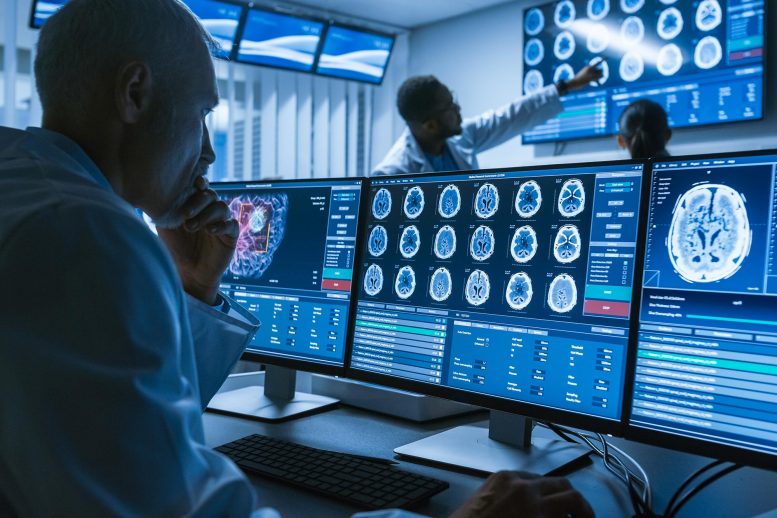
Reducing dangerous swelling in traumatic brain injury: Injected nanoparticles reduce swelling and secondary brain damage in preclinical research.
- ‘We believe this may provide the first real treatment for people with traumatic brain injury’
- Brain swelling after injury causes severe secondary damage, even death
- Traumatic brain injuries affect more than 2.5 million people in the U.S. each year
- Could be first-line treatment for professional and young athletes
After a traumatic brain injury, the most harmful damage is caused by secondary swelling of the brain compressed inside the skull. There is no treatment for this.
In new research, Northwestern Medicine scientists were able to significantly reduce brain swelling and damage after a traumatic brain injury by injecting nanoparticles into the bloodstream within two hours after the injury, they report in a preclinical study.
“The results are vastly better than we predicted,” said Dr. Jack Kessler, professor of neurology at Northwestern University Feinberg School of Medicine and senior author on the paper. “We believe this may provide the first real and practical treatment for people who have a significant traumatic brain injury.”
The study will be published today (January 22, 2020) in Annals of Neurology.
The nanoparticles are made of an FDA-approved material table and could easily be loaded into a syringe and given immediately after traumatic brain injury in the field by emergency medical technicians or in the emergency room to prevent secondary damage, Kessler noted.
The scientists have begun first steps to obtain FDA approval for a clinical trial.
Traumatic brain injuries affect approximately 2.5 million people in the U.S. each year, according to a 2010 Centers for Disease Control report. However, these numbers don’t account for individuals who did not receive medical care, had outpatient care, or received care at a federal facility, such as persons serving in the U.S. military. Soldiers who serve in the U.S. military are at high risk for traumatic brain injury.
After a traumatic brain injury, the body launches an inflammatory reaction that triggers a cascade of immune responses that result in brain swelling.
“A patient can come into the emergency department walking and talking but then their brain swells. They immediately go downhill and can die,” Kessler said. “Now, the only thing a surgeon can do is open the skull up to relieve the pressure, but the brain still continues to swell.”
How nanoparticles prevent dangerous swelling
The nanoparticles work as a decoy to distract the immune cells from charging into the brain and causing more damage. The particles, named IMPS for immune modifying nanoparticles, are merely empty shells and do not contain any drugs or cargo.
After a traumatic brain injury, a specific population of monocytes — large white blood cells — rush to the injury site and attempt to clean up debris from damaged brain cells and secrete inflammatory proteins that stimulate other immune cells. This immune cascade produces swelling and inflammation that inadvertently damages surrounding healthy brain tissue.
But when the scientists inject the nanoparticles into the bloodstream shortly after the injury, these monocytes are tricked into thinking the nanoparticles are invading foreign materials. They engulf the particles and usher them to the spleen for disposal. The distracted monocytes are no longer around to enter the brain and cause problems.
In the study, mice that received the nanoparticles after a traumatic brain injury had greatly reduced swelling and half the damage to brain tissue compared to those who did not receive the nanoparticles. One of the injury models mimicked a closed head traumatic brain injury common in humans. In that model, the animals’ motor and visual function improved after the nanoparticle injection.
“We predicted there would be an effect, but the effect turned out to be quite startling. It is remarkable how well the animals do,” said lead author Sripadh Sharma, a Feinberg MD-PhD student.
Sharma, who is doing his neurology rotation, sees potential for helping young and professional athletes as well as soldiers. “These particles selectively knock out the damaging cells that begin infiltrating the brain within a couple of hours of the injury and reach their peak in three days. We can intervene before the secondary damage begins.”
Northwestern scientist Stephen Miller originally co-developed the nanoparticles to introduce food allergens to the immune system to create tolerance in food allergies. The microparticles also were used to treat multiple sclerosis by introducing myelin to the immune system to reduce its reactivity to it.
Nanoparticles for heart attack, colitis and West Nile Encephalitis virus
Then, in a 2014 Science Translational Medicine paper, Miller noted that microparticles prevented death in mice infected with West Nile Encephalitis virus. That led to the work in other models of acute inflammation including heart attack, colitis, and peritonitis. Most recently, Miller began collaborating with Kessler, whose research focus is brain and spinal cord injury.
Reference: “Intravenous Immunomodulatory Nanoparticle Treatment for Traumatic Brain Injury” by Sripadh Sharma Ph.D.; Igal Ifergan Ph.D.; Jonathan E. Kurz MD, Ph.D.; Robert A. Linsenmeier Ph.D.; Dan Xu Ph.D.; John G. Cooper Ph.D.; Stephen D. Miller Ph.D. and John A. Kessler MD, 10 January 2020, Annals of Neurology.
DOI: 10.1002/ana.25675
Miller is the Judy Gugenheim Research Professor of Microbiology-Immunology at Feinberg.
The nanotechnology was licensed to COUR Pharmaceuticals Co., a biotech based in Northbrook, Illinois, co-founded by Miller. Miller, who is on the COUR scientific advisory board, is a stock grantee and a paid consultant for the company. Northwestern University has a financial interest in COUR.
The research was supported by grants F31 NS105451-02 from the National Institute of Neurologic Disease and Stroke, R01 AG054429 from the National Institute on Aging and R01 EB-013198 from the National Institute of Biomedical Imaging and Engineering, all of the National Institutes of Health.
Never miss a breakthrough: Join the SciTechDaily newsletter.